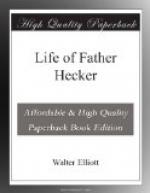But in the spring of 1858 arrangements had been made with Archbishop Hughes for establishing a house and parish in New York. The present site of St. Paul’s Church and convent, then in the midst of a suburban wilderness, was chosen, and, by dint of hasty collections from private friends and with the help of a very large gift from Mr. George Hecker, money enough was paid down to obtain the deeds. Sixtieth Street was not quite opened at the time, and this part of Ninth Avenue existed only on paper; but by energetic efforts made by all the Fathers and their friends, and by personal appeals in every direction, especially in the down-town parishes in which they had given missions, sufficient funds were raised to clear the ground and lay the foundations of a building which was to include both convent and church. Early in the summer of 1858 circulars asking assistance had been sent out to the clergy of the United States, and by this means also a considerable amount was secured, the very first answer with a handsome donation coming from Father Early, President of Georgetown College. In the spring of 1859 the Fathers rented a frame house on Sixtieth Street, just west of Broadway, fitted up a little chapel in it, and lived there in community till the new house was finished.
The corner-stone of the new structure was laid by Archbishop Hughes on Trinity Sunday, June 19, 1859, in the presence of an immense concourse of people. During that summer and fall every effort was made to keep the builders at work. The task was no easy one. The times were hard, the country still suffering from the effects of the financial crisis of 1857, the financial depression being aggravated by the ominous outlook in the political world. But the house was finally completed, and was blessed by Father Hecker on the 24th of November, the feast of St. John of the Cross, one of his very special patrons. This was within a few weeks of his fortieth birthday. On the 27th of the same month, the first Sunday of Advent, the chapel was blessed and Solemn Mass was celebrated in it. Thereafter the Fathers had to act as parish priests as well as missionaries. A few weeks before this the first recruit joined the little band in the person of Father Robert Beverly Tillotson, a convert, who, though an American, had been for some time a member of Dr. Newman’s Oratory. He was a charming preacher and a noble character, much beloved by all the fathers, and especially by Father Hecker. He died, deeply mourned, in the summer of 1868, having given the community nine years of most valuable service. He came just in time to set free three of the Fathers for missionary duty, the other two remaining in care of the parish. This was at first small enough in numbers, though in territory it reached from Fifty-second Street to very near Manhattanville. The accession of Father Alfred Young, of the diocese of Newark, and the return of Father Walworth considerably relieved the pressure, though the rapid growth of the parish and the widening scope of the community’s labors kept every one busy enough.




